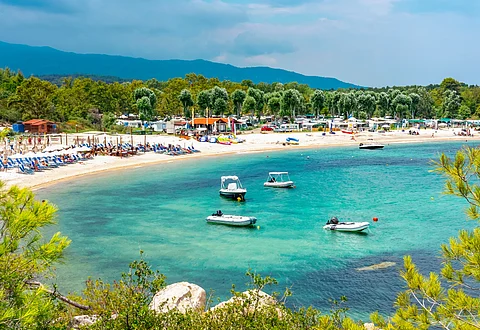
- Destinations
- Experiences
- Stay
- What's new
- Celebrating People
- Responsible Tourism
- CampaignsCampaigns
- SubscribeSubscribe
- Buy Now

Nestled in northern Greece, Halkidiki (also spelled Chalkidiki) is a beautiful peninsula known for its beaches, azure waters, and rich cultural heritage. Shaped like a trident jutting into the Aegean Sea, this region is divided into three distinct "fingers" or peninsulas—Kassandra, Sithonia, and Mount Athos—each offering unique experiences for travellers. Whether you’re seeking nightlife, nature, or spiritual retreats, Halkidiki has something for everyone.
The first "finger," Kassandra, is the most developed and is renowned for its lively atmosphere. This peninsula is ideal for visitors who enjoy bustling beach bars, luxury resorts, and energetic nightlife. Kallithea and Pefkohori are among its most popular spots, offering entertainment and crystal-clear beaches. Afytos provides a quieter option for families with its charming cobblestone streets and traditional taverns serving Greek cuisine. Kassandra is also home to natural wonders like the Loutra Pozar thermal springs, which are perfect for relaxation and rejuvenation.
The second peninsula, Sithonia, is a haven for those seeking unspoiled beauty and serenity. Known for its secluded beaches, pine forests, and turquoise bays, it offers a more peaceful experience. Popular beaches like Kavourotrypes and Kalamitsi boast sands and calm waters, ideal for snorkelling and sunbathing. The coastal villages of Neos Marmaras and Nikiti offer a blend of rustic charm and modern comforts, with traditional seafood tavernas and boutique accommodations. Sithonia is also perfect for outdoor enthusiasts, with hiking trails that lead to panoramic views of the Aegean.
The third "finger," Mount Athos, is a UNESCO World Heritage Site and a spiritual centre of Orthodox Christianity. Known as the "Holy Mountain," it is home to 20 monasteries, some of which date back over a thousand years. Access to this peninsula is restricted; only male pilgrims with special permits can visit. However, visitors can take boat tours around Mount Athos to admire its dramatic landscapes and historic monasteries from the sea. The sacred aura of Mount Athos adds a spiritual dimension to Halkidiki's allure.
Halkidiki boasts some of Greece's most beautiful beaches, many of which are Blue Flag certified for their cleanliness and facilities. Sani Beach in Kassandra and Karidi Beach in Sithonia are just two examples of the peninsula’s coastal gems. Beyond beach-hopping, visitors can enjoy water sports like scuba diving, windsurfing, and sailing. For those who prefer land-based activities, the region offers vineyard tours, olive grove excursions, and archaeological sites such as the ancient city of Olynthos.
Halkidiki’s culinary scene is a feast for the senses, showcasing local delicacies like fresh seafood and honey and traditional dishes such as moussaka and souvlaki. Pair your meals with wines from the region’s vineyards, particularly the renowned Malagouzia and Assyrtiko varieties. Many family-run tavernas and upscale restaurants provide an authentic taste of Halkidiki's gastronomic heritage.
Stay: For accommodations, Halkidiki offers a range of options, from luxurious resorts in Kassandra to guesthouses in Sithonia and even spiritual retreats near Mount Athos. No matter your budget, you’ll find a welcoming place to stay that matches your preferences.
Best Time To Visit: The best time to visit Halkidiki is between May and September when the weather is warm, and the beaches are at their best. The shoulder months of May, June, and September offer a more peaceful experience, avoiding the peak tourist crowds of July and August.
Visa Requirements: Greece is part of the Schengen Area, so travellers from Schengen Zone countries can enter visa-free. For non-Schengen nationals, such as those from the US, Canada, Australia, or the UK, short visits (up to 90 days within 180 days) typically do not require a visa.
However, travellers from countries requiring a visa to enter the Schengen Area must apply for a Schengen Visa. The process involves submitting an application to the Greek consulate or embassy in your home country providing supporting documents like a valid passport, travel insurance, proof of accommodation, and a return flight ticket.
From 2025, non-EU travellers eligible for visa-free entry must register online via the European Travel Information and Authorization System (ETIAS) before departure. Check Greece’s official government website or consult your local consulate for the most updated visa regulations before planning your visit.
Getting There: Halkidiki is easily accessible via Thessaloniki, the nearest city with an international airport. You can reach Halkidiki by car, taxi, or bus from Thessaloniki. The journey takes 1-2 hours, depending on your destination within the peninsula. Renting a car is recommended for exploring its three diverse "fingers."
